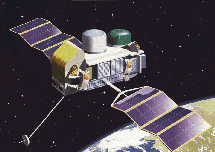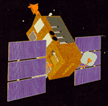RXTE Discoveries
The Universe Lights Up on Beethoven's Birthday: RXTE Pinpoints Location of Gamma Ray Burst - December 1999
by Christopher Wanjek
 |
Ludwig van Beethoven would have been impressed. On December 16, the 229th anniversary of the musician's birth, the Universe lit up in gamma rays that, for a few seconds, outshone the entire sky
|
The event was a gamma-ray burst and was soon dubbed the "Beethoven Burst" by Dr. Brad Schaefer of Yale University. Satellites detect two or three gamma-ray bursts a day, but a burst this bright only happens once in maybe four years.
"This was by far the brightest burst we've detected in a long time," said Dr. Frank Marshall, a NASA astrophysicist at Goddard Space Flight Center. "I knew we had to find its location quickly. Otherwise, all the powerful optical and X-ray telescopes would not be able to study this monster event.
Gamma-ray bursts are by far the most energetic events known in the Universe, second only in power to the Big Bang. The gamma rays themselves are invisible to the human eye; they are the most energetic form of radiation, more powerful than optical light, ultraviolet radiation and X-rays.
The cause of these bursts is not known. Most scientists believe they come from the farthest reaches of the Universe, perhaps from the merging of two black holes or from a massive star explosion. If a burst ever originated nearby in our Galaxy, the bath of radiation could cause mass extinction on Earth.
Catch a Bursting Star
The Beethoven Burst was one of those rare and spectacular explosions that lasted long enough and shone bright enough for scientists to study it in-depth. Although a little ingenuity didn't hurt.
Scientists have difficulty studying gamma-ray bursts because they appear randomly and without warning, and they last only a few seconds. To maximize their catch, scientists have devised a computer network for satellites and ground-based telescopes that quickly spreads the news of a burst so that at least one telescope can get a good look before the burst fades.
 CGRO |
The two main satellites that first detect gamma-ray bursts are NASA's Compton Gamma-Ray Observatory (CGRO) and the Italian-Dutch BeppoSAX satellite. When these satellites sense a burst, they transmit the approximate burst location through the Gamma-Ray Burst Coordinates Network (GCN). The GCN, operated by NASA Goddard Space Flight Center, then notifies scores of telescopes around the globe.
|  Beppo-SAX |
On January 23, 1999, the GCN struck gold when it notified a robotic telescope called ROTSE with a crude source location only ten seconds into a burst. ROTSE was able to capture the first optical image of a gamma-ray burst while it was bursting.
The Beethoven Burst, which goes by the more technical name GRB 991216, was not seen by ROTSE because the event happened during the daytime over New Mexico, where ROTSE is located. But in space, the Rossi X-ray Timing Explorer (RXTE) got a long, hard look at Beethoven's birthday candle.
As Seconds Tick Away...
For gamma-ray bursts, there is the burst and there is the afterglow. The afterglow can last for days and, as BeppoSAX discovered, glow in the X-ray band. Most of what scientists know about gamma-ray bursts come from studies of the afterglow.
RXTE doesn't catch many gamma-ray bursts. RXTE is an X-ray telescope that usually spends its time observing neutron stars, X-ray pulsars and possible black holes. Yet when RXTE got the signal from CGRO (via the GCN) about the Beethoven Burst, the RXTE science team decided to check it out.
|
The folks at RXTE knew they couldn't capture the gamma-ray burst while it was actually going off. Bursts rarely last more than a minute, and it would take several hours before RXTE could slew around to look for the burst. RXTE's plan was to capture the afterglow of the burst and notify the other telescopes through the GCN with a more precise burst location. One such telescope is the powerful Keck telescope in Hawaii. Keck is so powerful that it can detect optical light from some bursts several days and even months afterwards. But it needs the fine detail about the source location.
|  Rossi X-ray Timing Explorer |
The first step for RXTE was to detect the gamma-ray burst. CGRO churns out a crude burst location within a few seconds of a burst. The brighter the burst, the better the estimate. Within about an hour, though, CGRO had a better idea of where the Beethoven Burst came from. RXTE control center picked up on this later location estimate, still covering a large region of the sky and certainly not a pinpoint. Fortunately, RXTE has a wide-enough field of view and some ingenious software, so it can take CGRO's estimate of the source location and make the best of it.
This RXTE software was developed after the RXTE launch when scientists realized that gamma-ray bursts do indeed glow brightly for many hours after the burst in X-rays. Essentially, it enables RXTE to do something it was never meant to do.
"After receiving the improved BATSE position [an instrument aboard CGRO], RXTE scientists used special planning software to plan a series of spacecraft maneuvers to search for the X-ray afterglow of the burst," said Dr. Marshall, one of the key scientists working with RXTE. "The maneuvers are designed so that a new source anywhere in the BATSE error circle will be detected twice. The location of the new source can then be determined by correlating the X-ray count rate with the orientation of the satellite."
Show me what RXTE saw!
A Prelude to Joy
RXTE saw the Beethoven afterglow within four hours and nailed down a tighter location. Whereas the CGRO location was somewhere within a 4-degrees circle (about eight times the apparent width of the moon), RXTE chiseled the source down to 0.04-by-0.3 degrees in size. Another scan 10 hours later pinned it down to 0.04-by-0.08 degrees.
Without RXTE's efforts, the burst would have been lost. BeppoSAX was not looking in the direction of the burst, and CGRO couldn't provide anymore detail to the source location. RXTE's tighter constraints on a source location allowed powerful ground telescopes to zoom in for a closer look. These telescopes are built to observe faint sources in a narrow field of view with great accuracy.
"It's a bit like the little engine that could," said Dr. Patricia Boyd, a scientists who analyzes RXTE data at Goddard Space Flight Center. "RXTE lost one of its antennae recently. Yet not only can we continue to do our day-to-day science, we can also zoom around and catch a gamma-ray burst."
The first ground-based observatory to catch the optical afterglow was the MDM of Kitt Peak, Arizona, which recorded a fading magnitude 18.7 source. Several observatories have since trained on the burst and recorded a steadily declining afterglow in optical and radio wavelengths.
Even the Chandra X-ray Observatory was able to catch the fading embers just four days after the event, a remarkable bit of reprogramming for so complex a facility. This was Chandra's debut in the gamma-ray burst hunt.
An Exuberant Beethoven Fan
An approximate value for the redshift of the Beethoven Burst puts it more than 10 billion light years away, roughly 2 billion years after the Big Bang. Yet what caused this burst? A neutron star smashing into a black hole? A "hypernova," 100 times more powerful than the already potent supernova? Or maybe a real gung-ho Beethoven fan?
Two new NASA satellites will radically improve scientists' ability to study gamma-ray bursts and determine their origin. The High-Energy Transient Explorer (HETE-2) will launch in late January, 2000, followed by the Swift mission in 2003. These missions will help scientists study the burst itself, not just the afterglow.
Current satellites have whetted scientists' appetite for gamma-ray bursts. These bursts have been studied for 40 years, but only recently -- through the information provided by the likes of CGRO and BeppoSAX -- have scientists come to understand how powerful, how distant and how pervasive these bursts really are.
HETE-2 and Swift will dedicate themselves to gamma-ray bursts. Their primary goal is to relay incredibly precise burst locations within seconds, not hours. Depending on how one measures accuracy (better resolution or ability to find quick location), these satellites will be 100 to 1,000 times better at studying gamma-ray bursts.
New Satellites Dedicated to Locating Bursts
HETE-2 will detect up to a thousand bursts a year and, for about 30 of these bursts, provide very detailed information about their location and spectra, or light characteristics, within minutes. This is collaboration among MIT, France and Japan.
Swift, to be built by NASA Goddard, hopes to chop the relay time down to 15 seconds with even more precise coordinates -- a 1 to 4 arc-minute position, tight enough for Keck and Chandra to use. Swift also has telescopes on board that will determine an arc-second position of a burst within a few minutes and also determine the redshift, or distance, to the burst source.
With this type of rapid response and precision, scientists hope to finally get a handle on the location and nature of gamma-ray bursts, by far the most powerful events known.
No one knows when the next really big burst will come. Perhaps on Mozart's birthday, perhaps on yours. When ever it comes, gamma-ray astronomers plan to be ready.


